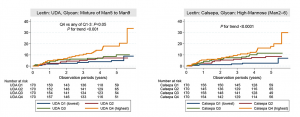A group from Okayama University Graduate School of Medicine, Dentistry and Pharmaceutical Sciences, etc. has reported new urinary biomarkers for cardiovascular events originating from Type 2 diabetes.
https://www.frontiersin.org/articles/10.3389/fcvm.2021.668059/full
Targeting cardiovascular events (CVE) as one of primary outcomes originating from the diabetes, urinary glycomes in 680 patients with type 2 diabetes were evaluated with using Lectin microarrays.
During approximately a 5-year follow-up period, 62 patients reached the endpoint. Cox proportional hazards analysis revealed that urinary glycan signals binding to two lectins were significantly associated with the outcome after adjustment for known indicators of CVE and for false discovery rate, as well as increased model fitness. Hazard ratios for these lectins (+1 SD for the glycan index) were UDA (recognizing glycan: mixture of Man5 to Man9): 1.78 (95% CI: 1.24–2.55, P = 0.002) and Calsepa [High-Man (Man2–6)]: 1.56 (1.19–2.04, P = 0.001). Common glycan binding to these lectins was high-mannose type of N-glycans.
The urinary excretion of high-mannose glycan may be a valuable biomarker for improving prediction of CVE in patients with type 2 diabetes. It is still unclear what kinds of mechanisms are underlaying such abnormal N-glycosylation.

